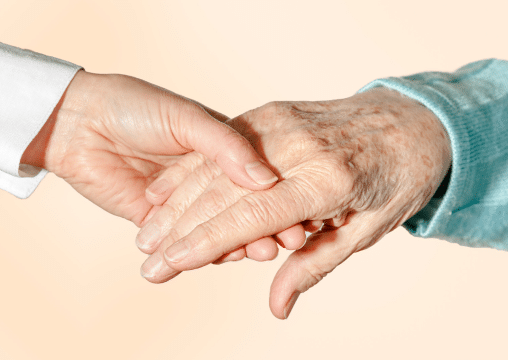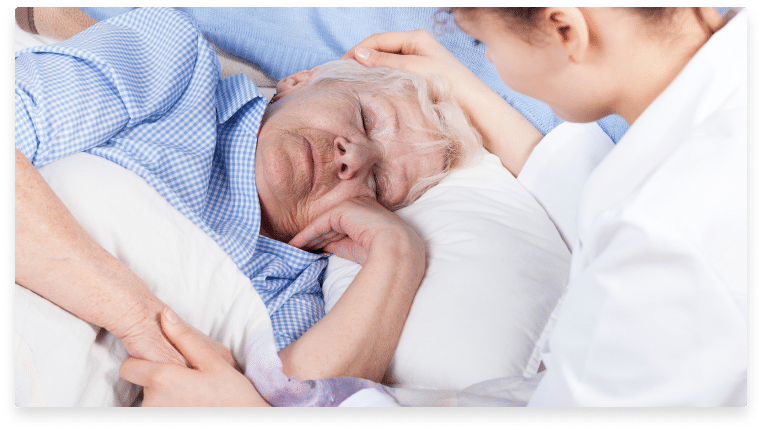Stage 3 Bedsores
Stage 3 bedsores involve the destruction of both the outer layer of skin (epidermis) and the deeper layer of skin (dermis). This results in a deep, open wound that may appear as a crater or involve tunneling into the tissue. Treatment typically involves wound care and management of underlying medical issues.

- What is a stage 3 bedsore?
- Stage 3 Bedsores Are Often the Result of Neglect
- Signs and Symptoms of Stage 3 Bedsores
- Where do stage 3 bedsores commonly occur on the body?
- How serious are stage 3 bedsores?
- Who’s most at risk of developing stage 3 bedsores?
- Diagnosing Stage 3 Bedsores
- Treating Stage 3 Bedsores
- What is the life expectancy of a patient with stage 3 bedsores?
- What are the long-term effects of stage 3 bedsores?
- Are stage 3 bedsores preventable?
- Nursing Home Neglect and Abuse Laws
- Reporting Nursing Home Abuse and Neglect
- Resources for Nursing Home Residents and Family Members
What is a stage 3 bedsore?
The other name for bedsores—pressure ulcers—indicates how they occur. Prolonged pressure on your body cuts off the blood supply to your skin. Blood delivers oxygen and nutrients to your cells, and without oxygen and nutrients, cells die. When enough cells die, a skin wound emerges.
Longer pressure will worsen a wound. Pressure over a few hours may discolor the skin but not cause any lasting injury. Pressure over a few days may cause an open wound that bleeds or seeps pus.
Doctors use a four-stage scale to rate bedsores. This scale identifies bedsore signs, treatments, and recovery time for each stage.
The scale does not include a stage for severe full-thickness tissue loss. At this stage, a layer of slough or eschar—dead skin, dried blood, and other scab material—covers the wound. Doctors need to clear away the dead tissue to determine the depth of the wound.
Stages 1 and 2 may only require a shifting of the patient’s position and application of first aid. Stage 3 bedsores usually require medical treatment.
Stage 3 and 4 bedsores have a high risk of infection. In these cases, the sore has reached the fatty layer or even the muscle or bone underneath. Doctors will treat and investigate the causes of such severe wounds to reduce the likelihood of recurrence.

Stage 3 Bedsores Are Often the Result of Neglect
Seniors, particularly those with mobility issues, have a high risk of developing bedsores. Pressure on the skin from a bed, wheelchair, cast, or brace can create conditions that lead to bedsores. Caretakers must work diligently to prevent bedsores and watch for any signs of development.
Neglect can lead to stage 3 bedsores in the following three ways:
Not Enough Movement
Bedsores begin forming within one hour of sustained pressure and fully develop after four to six hours. This means that caretakers must move immobile patients once every four hours, at minimum, to avoid stage 1 bedsores.
For a stage 3 bedsore to develop, caretakers would need to neglect this basic duty for an extended period. If a patient develops a stage 3 bedsore, this indicates that caretakers had not moved the patient for six hours or longer.
Not Discovering Early-Stage Bedsores
Since bedsores can begin in as little as one hour, even the most diligent caretaker may have patients with stage 1 bedsores. Still, that caretaker should find the bedsores and treat them, avoiding progression to stage 3.
If a patient has stage 3 bedsores, it suggests that the caretaker neglected their duty of regularly inspecting the patient’s body for bedsores.
Not Treating Early-Stage Bedsores
After bedsores develop, individuals in long-term care facilities and nursing homes should receive adequate treatment. If left untreated, bedsores will advance to later stages, and the resulting health complications can be deadly.
Caretakers can treat bedsores in their early stages simply by relieving the pressure on the injury. For example, if a pressure spot develops on a patient’s right hip, the caretaker can rotate the patient on their back and left side until the sore heals.
For bedsores to reach stage 3, the caretaker may have allowed a stage 1 bedsore to worsen through neglect of proper treatment.
Signs and Symptoms of Stage 3 Bedsores
At stage 1, bedsores only affect the epidermis, which is the outer layer of the skin. In stage 2, bedsores spread to affect the dermis, which is the deeper layer of the skin. However, in both cases, the bedsore is still confined to skin tissue. The skin becomes discolored, and there may be a closed or an open wound. Stage 1 and 2 bedsores require care and first aid to avoid the risk of infection, but they don’t always require advanced medical care.
Ideally, patients with bedsores at any stage should receive adequate medical treatment from a qualified health care professional. Once bedsores reach stage 3, the patient needs to see a doctor. Signs of a stage 3 bedsore include:
- Pain, burning, or itching
- Discolored skin that appears red, blue, or purple
- An open wound with broken skin that looks cratered or pitted
- Exposed fatty tissue in the wound
Stage 3 bedsores involve the full thickness of the skin. As a result, the skin that died in stages 1 and 2 may accumulate in the wound. Dead skin cells (slough) and scab tissue (eschar) may cover the wound.
The depth of a stage 3 bedsore puts one at risk for infection. Signs of an infection include:
- Pus or other fluids draining from the wound
- Swelling
- Warmth around the wound
- Rotten smell
In a worst-case situation, the infection can spread to the rest of the body. The patient may show signs of sepsis, like fever, racing heart, clammy skin, and extreme pain.
Where do stage 3 bedsores commonly occur on the body?
Stage 3 bedsores often affect pressure points. Some common locations of bedsores include:
- Hips
- Shoulder blades
- Buttocks, particularly over the tailbone
- Back of the head
- Heels
- Backs and sides of knees
If you believe your loved one has developed bedsores, inspect wherever their body presses on the mattress or wheelchair.
How serious are stage 3 bedsores?
Bedsores can have severe health consequences. The sores result from a lack of blood circulation. The skin tissue dies and exposes lower layers of tissue—such as fat, muscle, and bone—to pressure, microorganisms, and chemicals released by the dead cells.
Stage 3 bedsores require immediate attention to prevent infection and a worsening of the sore into a stage 4 bedsore.
You must determine the cause of the bedsores. Bedsores in their earlier stages can advance to stage 3 if the cause goes unresolved. Further, without addressing the cause, the pressure can result in additional lesions.

Who’s most at risk of developing stage 3 bedsores?
Stage 3 bedsores happen most frequently in people who meet one or more of the following conditions.
Elderly
As you age, your skin becomes drier, thinner, and less malleable. As a result, seniors’ fragile skin tears and breaks down more easily.
Obese
Obese patients place greater pressure on their skin. As a result, they’re more likely to develop bedsores than patients who weigh less.
Poor Circulation
People with circulatory disorders, such as diabetes or cardiovascular disease, have a higher risk of bedsores.
Mobility Disability
The best way to avoid bedsores is to move periodically. People with mobility disabilities rely on caretakers to move them.
People in nursing homes and other long-term care facilities face a high risk of bedsores since they’re often elderly and have mobility issues. If caretakers neglect to regularly rotate and reposition them, they can develop bedsores that progress into stage 3.
Diagnosing Stage 3 Bedsores
Stage 3 bedsores have an open wound. This wound reaches through the skin and into the fatty layer. However, the wound does not reach the muscle, tendon, or bone—this deep wound happens in a stage 4 bedsore.
To diagnose a stage 3 bedsore, doctors may need to remove any scab tissue, dried blood, and dead skin to examine the sore and clean the wound.
Diagnosing the correct stage of a bedsore allows doctors to prescribe the proper treatment. Stage 4 bedsores require surgery to excise dead tissue and clean the wound. In contrast, stage 1 and 2 bedsores usually only require first aid to prevent infection.
Stage 3 bedsores fall in the middle. Doctors usually don’t operate on stage 3 bedsores, but they may prescribe antibiotics and clean the wound to reduce the risk of infection.
Treating Stage 3 Bedsores
Stage 3 bedsores require professional medical help to diagnose and treat. Treatment focuses on three aspects of the bedsore:
Cleaning
Doctors will clean the wound of dead tissue. The dead tissue can harbor bacteria and lead to infection. It can also slow the healing process.
Treating Infection
Doctors will treat and prevent infection by prescribing antibiotics. These medicines may include topical ointments applied to the wound and ingestible antibiotics to prevent the infection from spreading to the rest of the body.
Prevention
When faced with a serious, preventable injury like a stage 3 bedsore, doctors have an ethical duty to investigate the conditions that led to the injury. Once they determine the cause, doctors can prescribe measures to address factors that contributed to the injury, including:
- Hydration
- Nutrition
- Patient movement
In many states, doctors must report signs of caretaker neglect. To inspect for possible neglect, they will often ask caretakers about factors that may have caused the injury.
What is the life expectancy of a patient with stage 3 bedsores?
Bedsores can lead to serious complications, like sepsis. But bedsores, by themselves, will not shorten a patient’s life.
Early detection and treatment can prevent bedsores from impacting a patient’s life expectancy. Conversely, allowing bedsores to worsen to stages 3 or 4 could lead to fatal complications.
What are the long-term effects of stage 3 bedsores?
Patients can fully recover from the physical effects of stage 3 bedsores.
However, stage 3 bedsores might signify neglect. Neglect can endanger the patient’s mental and physical health. Nursing homes and long-term care facilities that neglect patients should be held liable.
Are stage 3 bedsores preventable?
Caretakers can prevent bedsores.
Periodical movement will relieve the pressure that causes bedsores, so caretakers must move immobile patients to reduce the risk. Caretakers must also inspect immobile patients for bedsores while washing and dressing them.
When caretakers identify a bedsore, they must treat the ulcer or report it to medical staff for treatment.
Nursing Home Neglect and Abuse Laws
There are three main avenues for addressing nursing home neglect and abuse:
Criminal Laws
Assault, abuse, and neglect of all types towards nursing home residents could constitute a crime. Every state has an adult or elder protective services department. This department typically falls within the state’s department of health.
Adult protective services investigates abuse of vulnerable adults in nursing homes, long term care facilities and assisted living centers. Many of the investigators for adult protective services train through grants from the federal government provided by the Older Americans Act, the Elder Justice Act, and the Violence Against Women Act. However, these laws leave prosecution of elder abuse to the state.
If you report your loved one’s injuries to your state’s adult protective services department, investigators can check into the nursing home’s practices. If the nursing home has violated state laws against assault, abuse, or abandonment, the state can bring criminal charges.
Nursing Home Regulations
Every state regulates nursing homes. Most states also regulate long-term care facilities. If you report your concerns to your state’s licensing board, the facility could lose its license.
Civil Laws
The most immediate way to hold nursing homes responsible for physical abuse and neglect is to file a lawsuit. Nursing homes have a legal duty to provide reasonable care to residents. Stage 3 bedsores could suggest evidence of negligent or intentional behavior that breaches a proper duty of care.
A nursing home lawyer can use the following theories to file a lawsuit:
- Negligent hiring
- Negligent training
- Negligent supervision
- Inadequate procedures
Bedsores can also result when nursing homes use restraints. This practice can support a lawsuit for battery and false imprisonment.
Reporting Nursing Home Abuse and Neglect
When you suspect nursing home abuse or neglect, you should speak to a nursing home attorney and report it to your state’s adult protective services department. Your lawyer can begin the civil process of recovering compensation for the treatment of your loved one’s injury and for the pain and suffering they endured.
At the same time, the state can begin to investigate signs of abuse and look into the facilities practices to determine if the nursing home broke any laws.
Resources for Nursing Home Residents and Family Members
Nursing home residents and their families can avoid preventable injuries like stage 3 bedsores. If your loved one has any conditions that increase the risk of bedsores, have a discussion with the care facility about your expectations. Consider outlining your concerns in writing so you have a record of your instructions.
If you need to change nursing homes due to bedsore issues, visit the AARP’s caregiving web page for tips and care options.
If you suspect your loved one has developed bedsores due to neglect, contact your state’s adult protective services department. The National Adult Protective Services Association has a directory for all 50 states, plus Guam and Puerto Rico.
- Last Modified May 16, 2023
- Editorial Guidelines
Dr. Patricia Shelton, MD

Education:
- University of Washington, Doctor of Medicine – MD. June 2008
- University of Washington, Bachelor of Science – BS, Jun 2003
Background:
Neuroscience and Medicine
Career:
- Dr. Shelton primarily writes content for health-related websites, but has also written test prep materials, white papers, published research articles, court documents, and more.
- Dr. Shelton teaches anatomy and physiology at the college level for the National Institutes of Health.
Do You Need Help?
- Last Modified May 16, 2023
- Editorial Guidelines
Dr. Patricia Shelton, MD

Education:
- University of Washington, Doctor of Medicine – MD. June 2008
- University of Washington, Bachelor of Science – BS, Jun 2003
Background:
Neuroscience and Medicine
Career:
- Dr. Shelton primarily writes content for health-related websites, but has also written test prep materials, white papers, published research articles, court documents, and more.
- Dr. Shelton teaches anatomy and physiology at the college level for the National Institutes of Health.
